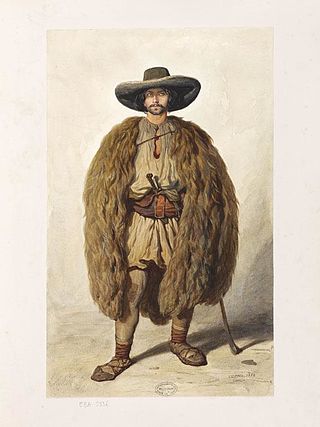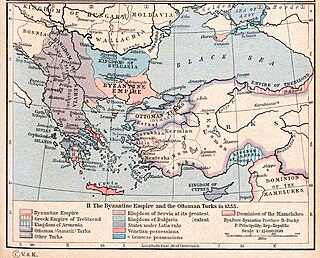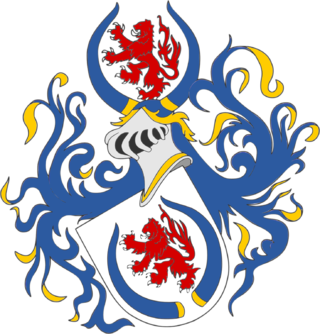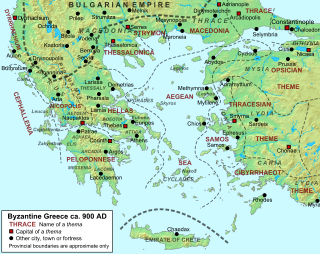
The Serbian Empire was a medieval Serbian state that emerged from the Kingdom of Serbia. It was established in 1346 by Dušan the Mighty, who significantly expanded the state.

Vlach, also Wallachian, is a term and exonym used from the Middle Ages until the Modern Era to designate speakers of Eastern Romance languages living in Southeast Europe—south of the Danube and north of the Danube.

The Serbian Orthodox Church is one of the autocephalous Eastern Orthodox Christian churches.

The House of Nemanjić was the most prominent dynasty of Serbia in the Middle Ages. This princely, royal and imperial house produced twelve Serbian monarchs, who ruled between 1166 and 1371.

The Balkan sprachbund or Balkan language area is an ensemble of areal features—similarities in grammar, syntax, vocabulary and phonology—among the languages of the Balkans. Several features are found across these languages though not all apply to every single language. The Balkan sprachbund is a prominent example of the sprachbund concept.
Kekaumenos is the family name of the otherwise unidentified Byzantine author of the Strategikon, a manual on military and household affairs composed c. 1078. He was apparently of Georgian-Armenian origin and the grandson of the doux of Hellas. Despite relevant suppositions, there exists no concrete evidence that he is the famous 11th century general Katakalon Kekaumenos, or his son.

The History of the Serbs spans from the Early Middle Ages to present. Serbs, a South Slavic people, traditionally live mainly in Serbia, Montenegro, Bosnia and Herzegovina, Croatia and North Macedonia. A Serbian diaspora dispersed people of Serb descent to Western Europe, North America and Australia.

The Kingdom of Montenegro was a monarchy in southeastern Europe, present-day Montenegro, during the tumultuous period of time on the Balkan Peninsula leading up to and during World War I. Officially it was a constitutional monarchy, but absolutist in practice. On 28 November 1918, following the end of World War I, with the Montenegrin government still in exile, the Podgorica Assembly proclaimed unification with the Kingdom of Serbia, which itself was merged into the Kingdom of Serbs, Croats and Slovenes three days later, on 1 December 1918. This unification with Serbia lasted, through various successor states, for almost 88 years, ending in 2006.

The House of Branković is a Serbian medieval noble family and dynasty. According to genealogies created in the first half of the 15th century, the family descends via female lineage, through marriage with the Nemanjić dynasty. The family rose to prominence during the fall of the Serbian Empire. The original family domains were centered in the Kosovo region. Later family members extended their rule over all remaining unconquered regions of Serbia making them the last sovereign rulers of medieval Serbian state. The dynasty ruled the Serbian Despotate from 1427 to 1459 and their descendants continue to claim the throne of the Despotate Serbia, some having entered the ranks of the Hungarian aristocracy, while other descendants of the dynasty continue to go by a courtesy title.

The Diocese of Dacia was a diocese of the later Roman Empire, in the area of modern western Bulgaria, central Serbia, Montenegro, Kosovo, northern Albania and northern North Macedonia. It was subordinate to the Praetorian prefecture of Illyricum. Its capital was at Serdica.

Dardania was a Roman province in the Central Balkans, initially an unofficial region in Moesia (87–284), and then a province administratively part of the Diocese of Moesia (293–337). It was named after the tribe of the Dardani who inhabited the region in classical antiquity prior to the Roman conquest.

Much of the territory of the modern state of Serbia was part of the Roman Empire and later the Eastern Roman Empire. In particular, the region of Central Serbia was under Roman rule for about 800 years, starting from the 1st century BC, interrupted by the arrival of the Slavs into the Balkans during the 6th century, but continued after fall of the First Bulgarian Empire in the early 11th century and permanently ended with the rise of the Second Bulgarian Empire in the late 12th century. The territories were administratively divided into the provinces of Moesia, Pannonia and Dardania. Moesia Superior roughly corresponds to modern Serbia proper; Pannonia Inferior included the eastern part of Serbia proper; Dardania included the western part of Serbia proper. After its reconquest from the Bulgarians by Emperor Basil II in 1018, it was reorganized into the Theme of Bulgaria.

Bulgaria has an embassy in Belgrade. Serbia has an embassy in Sofia. Bulgaria is a European Union member state and Serbia is a European Union candidate.

The Institute for Balkan Studies of the Serbian Academy of Sciences and Arts is a division of the Serbian Academy of Sciences and Arts that focuses on the historical, social, and anthropological study of the Balkans and its peoples. It is in the building of the Serbian Academy of Sciences and Arts in downtown Belgrade.

The best known cultural archaeological discoveries from the prehistoric period on the territory of modern-day Serbia are the Starčevo and Vinča cultures dating back to 6400–6200 BC.
The Tricornenses of Tricornum were a Romanized Thraco-Celtic artificially created community by the Romans that replaced the Celtic Celegeri. The inhabitants of Tricornum were Celtic and Thracian, attested by epigraphic sources. After 6 AD, the Tricornenses were one of the four units of Upper Moesia alongside the Dardani, Moesi and Picenses. The ceremonial parade armour found at Ritopek belonged to a Tricornian soldier of Legio VII Claudia, dating to AD 258.

The Theme of Dyrrhachium or Dyrrhachion was a Byzantine military-civilian province (theme), covering the Adriatic coast of modern Albania, and some coastal regions of modern Montenegro. It was established in the early 9th century and named after its capital, Dyrrhachium.
Philip J. Cohen is a former United Nations advisor on Bosnia and Herzegovina who has written several works on the history of the former Yugoslavia. He authored a noted book Serbia’s Secret War: Propaganda and the Deceit of History, first published in 1996 by Texas A&M University Press to mixed reviews. He followed this in 1997 with the publishing of The World War II and contemporary Chetniks: Their historico-political continuity and implications for stability in the Balkans by Ceres. In 1998, he received an award from Franjo Tuđman the President of Croatia for his "contribution in spreading the truth about the aggression against Croatia" and "exposing Great Serb and anti-Croat propaganda" through his books.
Balkan studies or Balkanology is the studies of the Balkans.
The Aromanian Missal is an anonymous Aromanian-language instructive liturgical book (missal) variously referred to as dating from the beginning, the first half, the middle and the second half of the 18th century. It is the first extensive text in Aromanian, and includes translations of sermons and other religious texts into Aromanian. The Aromanian Missal is believed to have been written in Moscopole, once a prosperous Aromanian city, and uses the Greek alphabet due to archaic forms of Greek being considered the appropriate language for high and literary functions in those times within the Balkans. In recent times, the text of the liturgy has begun to circulate more actively among the Aromanians in Albania with support from the Aromanian diaspora. In a 2002 study on the Aromanians, German researcher Thede Kahl stated that priest Thoma sang this Aromanian-language liturgy at the St. Nicholas Church of Moscopole.














